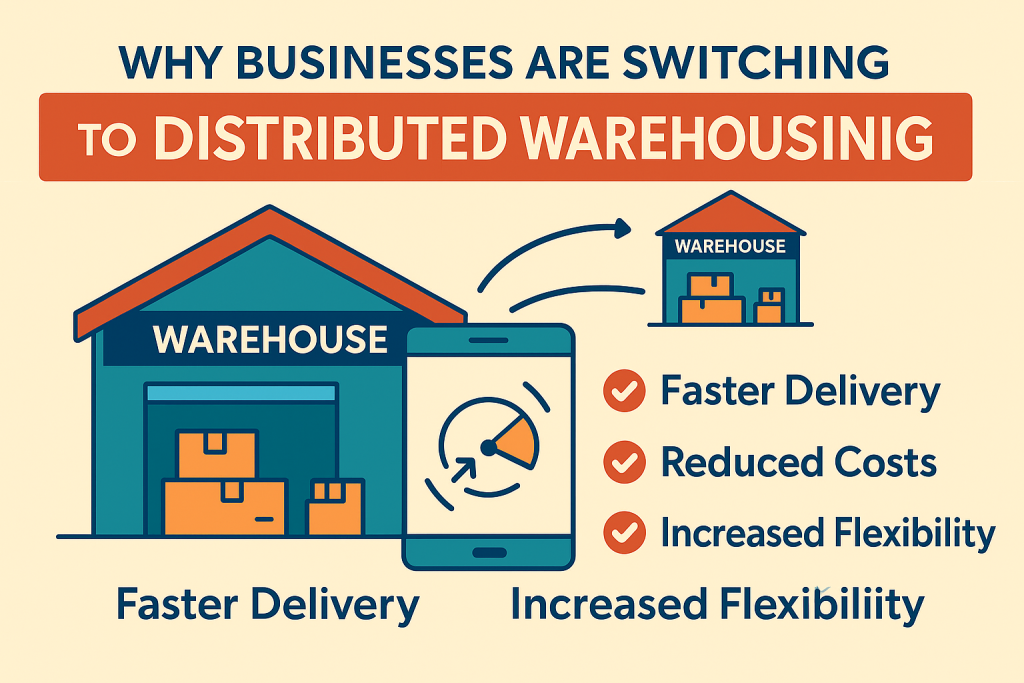By Martin Vassilev / 15 Aug, 2025

In today’s fast-paced, digitally driven marketplace, consumer expectations for speed, accuracy, and convenience have reached unprecedented levels. Traditional centralized warehousing models, while effective in the past, often fall short in meeting the demands of modern e-commerce, omnichannel retail, and global supply chains. This shift has given rise to distributed warehousing — a strategic approach where businesses store inventory across multiple, strategically located warehouses to improve delivery times, reduce shipping costs, and enhance customer satisfaction.
From startups scaling their fulfillment operations to global corporations optimizing complex supply chains, the migration toward distributed warehousing is accelerating. This article explores why so many companies are making the switch, the operational benefits, and how to implement a distributed warehousing strategy effectively.
Distributed warehousing involves deploying multiple storage and fulfillment centers across different geographic regions, closer to customers, retail partners, or production facilities. Rather than relying on one massive centralized hub, companies utilize a network of strategically placed warehouses to manage and distribute inventory.
This model not only accelerates delivery but also offers resilience against disruptions — a critical advantage in today’s unpredictable supply chain landscape.
Consumers expect fast shipping, with same-day and next-day delivery becoming industry norms. Distributed warehousing allows businesses to store products closer to customers, reducing transit times significantly.
For example, by positioning inventory in multiple hubs, an e-commerce brand can ship orders from the nearest facility, meeting customer expectations for lightning-fast delivery without exorbitant shipping costs.
Related Reading: How Smart Warehousing Solutions Improve Delivery Times
Long-distance shipping incurs high transportation costs, especially with volatile fuel prices and carrier surcharges. A distributed approach minimizes shipping zones, helping businesses cut costs while offering competitive delivery rates.
Additionally, fewer cross-country shipments reduce environmental impact, aligning with sustainable business goals.
The COVID-19 pandemic, geopolitical tensions, and extreme weather events have shown how overreliance on a single facility can cripple operations. Distributed warehousing provides redundancy — if one warehouse is disrupted, others can fulfill orders.
This risk-spreading capability ensures business continuity, which is crucial for industries such as healthcare, food, and consumer electronics.
With the rise of buy online, pick up in-store (BOPIS), curbside pickup, and same-day delivery, businesses need inventory positioned closer to multiple touchpoints. Distributed warehousing supports omnichannel strategies by enabling faster, more flexible order fulfillment.
For scaling businesses, distributed warehousing offers modularity. New warehouses can be added as the business expands into new markets, without overburdening existing facilities.
This is especially advantageous for seasonal retailers and global brands targeting emerging markets.
By leveraging technology like real-time inventory tracking systems, businesses can monitor stock levels across multiple locations and avoid costly stockouts or overstocks.
This optimization directly translates into improved cash flow and customer satisfaction.
Learn More: Real-Time Warehouse Tracking Systems: A Must-Have for Modern Logistics
Customers care about when their order arrives, not where it ships from. Distributed warehousing enables shorter delivery windows, fewer delays, and better order accuracy — factors that strongly influence brand loyalty and repeat purchases.
Shorter shipping distances mean fewer greenhouse gas emissions, which aligns with green logistics initiatives. Companies adopting distributed warehousing can market their sustainability efforts as a competitive differentiator.
External Resource: EPA’s Sustainable Transportation Initiatives
With multiple facilities, businesses can choose the optimal location for each order, balancing factors like cost, speed, and inventory availability.
This flexibility is particularly valuable during peak seasons, flash sales, or unexpected demand surges.
Analyze your customer base geographically. Use sales data to determine high-demand regions and potential warehouse locations.
For example, a Canadian retailer might place facilities in Ottawa, Vancouver, and Toronto to cover 90% of the population within two days.
Partnering with a third-party logistics (3PL) provider like ByExpress can make scaling distributed warehousing easier. These partners offer established networks, technology integration, and operational expertise.
Distributed warehousing requires seamless coordination between multiple locations. Warehouse management systems (WMS), order management systems (OMS), and real-time tracking tools ensure smooth operations and visibility.
Related: How to Leverage Data Analytics for Streamlined Inventory Management
Effective inventory allocation is critical. Overstocking one warehouse while understocking another can cause imbalances that affect order fulfillment. Use demand forecasting tools to position the right amount of stock in each location.
Set KPIs such as order accuracy rate, shipping time, and cost per order to measure warehouse performance.
Regularly review these metrics and adjust your strategy to maximize efficiency.
Opening and managing multiple warehouses involves significant investment. Businesses can mitigate this by leasing space in existing facilities or partnering with on-demand warehousing providers.
More locations mean more complexity. The solution lies in centralized inventory systems and accurate demand forecasting.
With multiple fulfillment centers, standardizing operations and training is essential to ensure consistent customer experiences.
An apparel retailer selling across Canada transitioned from a single Toronto warehouse to a distributed model with locations in Ottawa, Calgary, and Vancouver.
Within six months, they reduced average delivery times from 5 days to under 2 days, decreased shipping costs by 22%, and improved customer satisfaction scores by 35%.
With advances in automation, robotics, and AI — such as those discussed in The Future of Warehouse Automation: What Businesses Need to Know — distributed warehousing will become even more efficient and data-driven.
Expect smarter routing, predictive inventory allocation, and integration with sustainable transportation solutions.
External Insight: World Bank Logistics Performance Index
Distributed warehousing is no longer a niche strategy — it’s becoming a core supply chain model for businesses aiming to stay competitive in the era of instant commerce. By strategically placing inventory closer to customers, companies can lower shipping costs, speed up delivery, and enhance resilience.
For businesses seeking growth, flexibility, and a competitive edge, switching to distributed warehousing is not just an option — it’s a necessity.

“Thanks to Byexpress all my shipping and fulfillment costs are in line now”

“All my issues were solved by Byexpress team that I had with pervious 3pl provider.”

“Thank you Byexpress team could not done it without you guys.”

“Their integration and customer service were the key for me”

“Outstanding delivery service! The package was well-packaged, and
the delivery team was professional and courteous”

“Great and knowledgeable team to work with.”

Thanks, guys, for reducing my shipping rates
Ottawa Office
2411 Holly Lane
Ottawa, ON, K1V 7P2
Toronto Office
13-280 West Beaver Creek Road Unit #136
Richmond Hill, ON, L4B 3Z1
Alexandria Office
173 Kenyon Street West
Alexandria, ON, K0C 1A0
Montreal Office
4388 Saint-Denis Street Unit #200
Montreal, QC, H2J 2L1
California Office
155 North Riverview Drive
Anaheim Hills, CA, 92808
Call Us
Toll-Free: 1-866-744-7122
Local : 613-739-3000
Email Us
Multilingual Services










